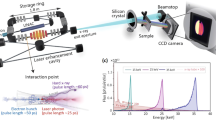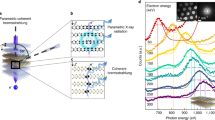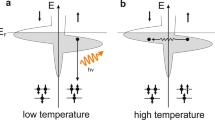Abstract
Since the discovery of X-rays by Roentgen in 1895, its use has been ubiquitous, from medical and environmental applications to materials sciences1,2,3,4,5. X-ray characterization requires a large number of atoms and reducing the material quantity is a long-standing goal. Here we show that X-rays can be used to characterize the elemental and chemical state of just one atom. Using a specialized tip as a detector, X-ray-excited currents generated from an iron and a terbium atom coordinated to organic ligands are detected. The fingerprints of a single atom, the L2,3 and M4,5 absorption edge signals for iron and terbium, respectively, are clearly observed in the X-ray absorption spectra. The chemical states of these atoms are characterized by means of near-edge X-ray absorption signals, in which X-ray-excited resonance tunnelling (X-ERT) is dominant for the iron atom. The X-ray signal can be sensed only when the tip is located directly above the atom in extreme proximity, which confirms atomically localized detection in the tunnelling regime. Our work connects synchrotron X-rays with a quantum tunnelling process and opens future X-rays experiments for simultaneous characterizations of elemental and chemical properties of materials at the ultimate single-atom limit.
This is a preview of subscription content, access via your institution
Access options
Access Nature and 54 other Nature Portfolio journals
Get Nature+, our best-value online-access subscription
$29.99 / 30 days
cancel any time
Subscribe to this journal
Receive 51 print issues and online access
$199.00 per year
only $3.90 per issue
Buy this article
- Purchase on Springer Link
- Instant access to full article PDF
Prices may be subject to local taxes which are calculated during checkout




Similar content being viewed by others
Data availability
All data are available in the main text, extended data and supplementary materials. The source data for the manuscript, for the extended data figures and Supplementary Figs. 13–16 are provided with the manuscript. All the theory data are deposited at https://doi.org/10.19061/iochem-bd-6-165. Source data are provided with this paper.
References
Wu, C.-Y. et al. High-spatial-resolution mapping of catalytic reactions on single particles. Nature 541, 511–515 (2017).
Rau, I. G. et al. Reaching the magnetic anisotropy limit of a 3d metal atom. Science 344, 988–992 (2014).
Lombi, E. & Susini, J. Synchrotron-based techniques for plant and soil science: opportunities, challenges and future perspectives. Plant Soil 320, 1–35 (2009).
van den Bedem, H. & Fraser, J. S. Integrative, dynamic structural biology at atomic resolution—it’s about time. Nat. Methods 12, 307–318 (2015).
Yano, J. & Yachandra, V. K. X-ray absorption spectroscopy. Photosynth. Res. 102, 241–254 (2009).
Bilderback, D. H., Elleaume, P. & Weckert, E. Review of third and next generation synchrotron light sources. J. Phys. B At. Mol. Opt. Phys. 38, S773–S797 (2005).
Eberhardt, W. Synchrotron radiation: a continuing revolution in X-ray science—diffraction limited storage rings and beyond. J. Electron Spectrosc. Relat. Phenom. 200, 31–39 (2015).
Chao, W. et al. Soft X-ray microscopy at a spatial resolution better than 15 nm. Nature 435, 1210–1213 (2005).
Meirer, F. et al. Synchrotron radiation-induced total reflection X-ray fluorescence analysis. Trends Anal. Chem. 29, 479–496 (2010).
Kotani, Y. et al. X-ray nanospectroscopy for attogram-scale two-dimensional nanomaterials using photoelectron emission microscopy. AIP Conf. Proc. 1234, 437–440 (2010).
Ivády, V. et al. Stabilization of point-defect spin qubits by quantum wells. Nat. Commun. 10, 5607 (2019).
Tagliabue, A. et al. The integral role of iron in ocean biogeochemistry. Nature 543, 51–59 (2017).
Gupta, V. B. et al. Aluminium in Alzheimer’s disease: are we still at a crossroad? Cell. Mol. Life Sci. 62, 143–158 (2005).
Saito, A. et al. Development of a scanning tunneling microscope for in situ experiments with a synchrotron radiation hard-X-ray microbeam. J. Synchrotron Rad. 13, 216–220 (2006).
Okuda, T. et al. Nanoscale chemical imaging by scanning tunneling microscopy assisted by synchrotron radiation. Phys. Rev. Lett. 102, 105503 (2009).
Rose, V. et al. Synchrotron X-ray scanning tunneling microscopy: fingerprinting near to far field transitions on Cu(111) induced by synchrotron radiation. Adv. Funct. Mater. 23, 2646–2652 (2013).
Shirato, N. et al. Elemental fingerprinting of materials with sensitivity at the atomic limit. Nano Lett. 14, 6499–6504 (2014).
Mairena, A. et al. Stereospecific autocatalytic surface explosion chemistry of polycyclic aromatic hydrocarbons. J. Am. Chem. Soc. 140, 7705–7709 (2018).
Wäckerlin, C. et al. On-surface coordination chemistry of planar molecular spin systems: novel magnetochemical effects induced by axial ligands. Chem. Sci. 3, 3154–3160 (2012).
Kersell, H. et al. Detecting element specific electrons from a single cobalt nanocluster with synchrotron X-ray scanning tunneling microscopy. Appl. Phys. Lett. 111, 103102 (2017).
Rose, V. et al. XTIP – the world’s first beamline dedicated to the synchrotron X-ray scanning tunneling microscopy technique. J. Synchrotron Rad. 27, 836–843 (2020).
Hla, S.-W., Bartels, L., Meyer, G. & Rieder, K.-H. Inducing all steps of a chemical reaction with the scanning tunneling microscope tip: towards single molecule engineering. Phys. Rev. Lett. 85, 2777–2780 (2000).
Repp, J., Meyer, G., Olsson, F. E. & Persson, M. Controlling the charge state of individual gold adatoms. Science 305, 493–495 (2004).
Margheriti, L. et al. X-ray detected magnetic hysteresis of thermally evaporated terbium double-decker oriented film. Adv. Mater. 22, 5488–5493 (2010).
van der Laan, G., Fuggle, J. C., van Dijk, M. P. & Burggraaf, A. J. Determination of the relative concentrations of rare earth ions by X-ray absorption spectroscopy: application to terbium mixed oxides. J. Phys. Chem. Solids 47, 413–416 (1986).
Thole, B. T. et al. 3d x-ray-absorption lines and the 3d94fn+1 multiplets of the lanthanides. Phys. Rev. B 32, 5107–5118 (1985).
Chang, H. et al. X-ray magnetic circular dichroism and near-edge X-ray absorption fine structure of buried interfacial magnetism measured by using a scanning tunneling microscope tip. Appl. Phys. Lett. 113, 061602 (2018).
Ikeno, H. et al. First principles calculation of Fe L2,3-edge X-ray absorption near edge structures of iron oxides. Mater. Trans. 45, 1414–1418 (2004).
Hla, S. W., Marinkovic, V., Prodan, A. & Musevic, I. STM/AFM investigations of β-MoTe2, α-MoTe2 and WTe2. Surf. Sci. 352–354, 105–111 (1996).
Vincent, R., Klyatskaya, S., Ruben, M., Wernsdorfer, W. & Balestro, F. Electronic read-out of a single nuclear spin using a molecular spin transistor. Nature 488, 357–360 (2012).
Zhang, Z. et al. Intra- and intermolecular self-assembly of a 20-nm-wide supramolecular hexagonal grid. Nat. Chem. 12, 468–474 (2020).
Newkome, G. et al. Nanoassembly of a fractal polymer: a molecular “Sierpinski hexagonal gasket”. Science 312, 1782–1785 (2006).
Li, Y. et al. Anomalous Kondo resonance mediated by semiconducting graphene nanoribbons in a molecular heterostructure. Nat. Commun. 8, 946 (2017).
Rose, V., Preissner, C. A., Hla, S.-W., Wang, K. & Rosenmann, D. Simultaneous topographic and elemental chemical and magnetic contrast in scanning tunneling microscopy. US patent 8,850,611 (2014).
Cummings, M. et al. Controlled modulation of hard and soft X-ray induced tunneling currents utilizing coaxial metal-insulator-metal probe tips. J. Appl. Phys. 121, 015305 (2017).
Kresse, G. & Hafner, J. Ab initio molecular dynamics for liquid metals. Phys. Rev. B 47, 558–561 (1993).
Kresse, G. & Hafner, J. Ab initio molecular-dynamics simulation of the liquid-metal–amorphous-semiconductor transition in germanium. Phys. Rev. B 49, 14251–14269 (1994).
Kresse, G. & Furthmuller, J. Efficiency of ab-initio total energy calculations for metals and semiconductors using a plane-wave basis set. Comput. Mater. Sci. 6, 15–50 (1996).
Kresse, G. & Furthmuller, J. Efficient iterative schemes for ab initio total-energy calculations using a plane-wave basis set. Phys. Rev. B 54, 11169–11186 (1996).
Anisimov, V. I., Aryasetiawan, F. & Lichtenstein, A. I. First-principles calculations of the electronic structure and spectra of strongly correlated systems: the LDA+U method. J. Phys. Condens. Matter 9, 767–808 (1997).
Perdew, J. P., Burke, K. & Ernzerhof, M. Generalized gradient approximation made simple. Phys. Rev. Lett. 77, 3865–3868 (1996).
Grimme, S., Antony, J., Ehrlich, S. & Krieg, S. A consistent and accurate ab initio parametrization of density functional dispersion correction (DFT-D) for the 94 elements H-Pu. J. Chem. Phys. 132, 154104 (2010).
Brena, B. & Herper, H. C. Influence of ligands on the electronic and magnetic properties of Fe porphyrin in gas phase and on Cu(001). J. Appl. Phys. 117, 17B318 (2015).
Zhang, Z. & Satpathy, S. Electron-states, magnetism, and the Verwey transition in magnetite. Phys. Rev. B 44, 13319–13331 (1991).
Dudarev, S. L., Botton, G. A., Savrasov, S. Y., Humphreys, C. J. & Sutton, A. P. Electron-energy-loss spectra and the structural stability of nickel oxide: an LSDA+U study. Phys. Rev. B 57, 1505–1509 (1998).
Frisch, M. J. et al. Gaussian 16 (Gaussian, Inc., 2016).
Becke, A. D. Density‐functional thermochemistry. III. The role of exact exchange. J. Chem. Phys. 98, 5648–5652 (1993).
Lee, C., Yang, W. & Parr, R. G. Development of the Colle-Salvetti correlation-energy formula into a functional of the electron density. Phys. Rev. B 37, 785–789 (1988).
Gill, P. M. W., Johnson, B. G., Pople, J. A. & Frisch, M. J. The performance of the Becke—Lee—Yang—Parr (B—LYP) density functional theory with various basis sets. Chem. Phys. Lett. 197, 499–505 (1992).
Schäfer, A., Horn, H. & Ahlrichs, R. Fully optimized contracted Gaussian basis sets for atoms Li to Kr. J. Chem. Phys. 97, 2571–2577 (1992).
Acknowledgements
We acknowledge financial support from the U.S. Department of Energy, Office of Science, Office of Basic Energy Sciences, Materials Science and Engineering Division. Work performed at the Center for Nanoscale Materials and Advanced Photon Source, both U.S. Department of Energy Office of Science User Facilities, was supported by the U.S. Department of Energy, Office of Basic Energy Sciences, under Contract No. DE-AC02-06CH11357. We gratefully acknowledge the computing resources provided on Bebop, a high-performance computing cluster operated by the Laboratory Computing Resource Center at Argonne National Laboratory.
Author information
Authors and Affiliations
Contributions
S.-W.H. conceived and designed the experiments. T.M.A., S.Wieghold, N.S., S.-W.H., V.R. and S.P. performed the SX-STM experiments. D.J.T., K.Z.L., S.S., S.Wang and Y.Li prepared the samples and performed STM imaging. T.M.A., S.Wieghold, N.S. and S.-W.H analysed the SX-STM data. Y.Li and X.L. synthesized the Fe and Ru assemblies. E.M. designed the Tb complex, X.C. synthesized it and N.K. obtained its X-ray crystal structure. D.R. and Y.Liu prepared the coaxial tips for SX-STM. T.R., N.K.D. and A.T.N. performed the calculations. All authors discussed the results and commented on the manuscript.
Corresponding authors
Ethics declarations
Competing interests
The authors declare no competing interests.
Peer review
Peer review information
Nature thanks the anonymous reviewers for their contribution to the peer review of this work.
Additional information
Publisher’s note Springer Nature remains neutral with regard to jurisdictional claims in published maps and institutional affiliations.
The submitted manuscript has been created by UChicago Argonne, LLC, Operator of Argonne National Laboratory (‘Argonne’). Argonne, a U.S. Department of Energy Office of Science laboratory, is operated under Contract No. DE-AC02-06CH11357. The U.S. Government retains for itself, and others acting on its behalf, a paid-up nonexclusive, irrevocable worldwide license in said article to reproduce, prepare derivative works, distribute copies to the public, and perform publicly and display publicly, by or on behalf of the Government.
Extended data figures and tables
Extended Data Fig. 1 XTIP beamline and SX-STM technique.
a, Schematic presentation of XTIP. b, Mechanistic model of the SX-STM process. (1) Photoabsorption process. (2) X-ray-excited electrons and Auger electrons with energies between the Fermi level EF and the work function Φ fill up unoccupied states of the sample, whereas those having energies exceeding the work function escape (‘X-ray-ejected electrons’). (3) X-ray-ejected electrons captured by the tip produce a photocurrent. (4) The electrons that fill up states between EF and Φ tunnel to the tip, generating an X-ray-excited tunnelling current. Both the X-ray-ejected electron current and X-ray-excited tunnelling current are produced by the same initial photoabsorption process (1). c, Left, photoabsorption process excites core-level electrons either to unoccupied orbitals below the work function or above the vacuum level, depending on the energy of the photon. This process leaves a hole in a core level. Right, in the de-excitation process, an electron from a higher level fills up the hole. The excess energy can cause the release of Auger electrons. d, Measured photon flux of the XTIP beamline.
Extended Data Fig. 2 Coaxial detector tip.
a, Transmission X-ray microscopy image of a detector tip shows several materials composing the tip. Scanning electron microscopy image of a detector tip before (b) and after (c) incision. Here the PtIr conducting core is used to collect electrons, whereas the SiO2 insulating layer prevents collection of ejected electrons from the sample by the side wall of the tip. The outer Au conducting layer is to protect from the charging effect34,35.
Extended Data Fig. 3 Formation of dimer complexes through Ullmann coupling.
a, STM images Tb(pcam-Br)3 on Au(111) acquired at 5 K substrate temperature. A single Tb- (pcam-Br)3 complex is indicated with a circle. Tb(pcam-Br)3 is mobile (indicated with arrows) during scanning with the STM tip even at 5 K. b, STM image of Tb(pcam-Br)3 clusters on Au(111). c, A model depicting debromination and covalent linking of two monomers (upper part). Heating the sample to 473 K results in the formation of a dimer, [Tb(pcam)3]2 (lower part). d, A model of [Tb(pcam)3]2. The yellow balls in c and d are Tb ions. e, An STM image of a dimer. f, A profile measured along the white line shown in e gives the length of the dimer as roughly 1.67 nm, which agrees well with the expected length of about 1.61 nm shown in d. Image parameters for a, b and e: It = 100 pA, Vt = 0.5 V.
Extended Data Fig. 4 Simultaneously measured X-ray-excited currents in the tunnelling regime before background subtraction.
Sample channel (a) and tip channel (b). Background subtraction is performed by setting the photocurrent at 702.5 eV to zero and applying a linear slope correction.
Extended Data Fig. 5 STM-XAS on Ru ions.
The supramolecular ring (see Fig. 1a and Extended Data Fig. 6b) includes only one Fe ion and the rest of the tpy bridges are formed by Ru ions. a–f, Simultaneously measured STM-XAS spectra in the sample and tip channels focusing on the Fe L3 edge region on the six <tpy-Ru-tpy> bridges. The tip channel in the tunnelling regime detects atomically localized signal and, thus, it does not show any Fe L3 edge signature when measured on the <tpy-Ru-tpy> bridges, because the Fe ions are not present there. However, the sample channel gives a strong Fe L3 edge signal because it is produced by the entire X-ray-illuminated surface area in which many supramolecular rings, each having one Fe ion, are present.
Extended Data Fig. 6 STM-XAS on different locations of a <tpy-Fe-tpy> bridge.
a, An STM image of a single supramolecular ring measured with the SX-STM setup. Image parameters: It = 100 pA, Vt = −1.0 V. b, Atomic positions of Fe and Ru ions in a. c–e, Simultaneously measured STM-XAS spectra in sample and tip channels in the tunnelling regime focusing on the L3 absorption edge of Fe. Cogent L3 edge signals of Fe ion are observed in both the sample and tip channels in c measured at the centre of the <tpy-Fe-tpy> bridge in which the Fe ion is located (position A in a). Weak Fe edge signals are observed when measured on the <tpy-Fe-tpy> bridge but the tip is not positioned on top of the Fe ion, such as in position B (d and e).
Extended Data Fig. 7 STM-XAS spectra of Tb M4,5 absorption edges in the far-field regime.
At the sample channel (a) and at the tip channel (b).
Extended Data Fig. 8 STM-XAS signals in the tunnelling regime when the tip is not on top of the Tb ion.
The sample channel (a) and the tip channel (b).
Extended Data Fig. 9 STM-NEXAFS spectra of Fe ion in the far field.
The sample channel (a) and the tip channel (b). The satellite peaks are labelled as i, ii, iii, iv, v and vi.
Extended Data Fig. 10 Theory calculations.
a, Spherically averaged potential of the <tpy-Fe-tpy> bridge on Au(111). The vacuum level is indicated. PDOS of combined Fe ‘d’ and N ‘p’ orbitals calculated by B3LYP/def2TZVP-based theory (b) and energy differences between the peaks in b with the experimentally measured data (c).
Supplementary information
Supplementary Information
This file contains details about the synthesis and characterization of Tb(pcam-Br)3, STM-XAS data before background subtraction, Supplementary Figs. 1–16, Supplementary Tables 1 and 2 and Supplementary References.
Source data
Rights and permissions
Springer Nature or its licensor (e.g. a society or other partner) holds exclusive rights to this article under a publishing agreement with the author(s) or other rightsholder(s); author self-archiving of the accepted manuscript version of this article is solely governed by the terms of such publishing agreement and applicable law.
About this article
Cite this article
Ajayi, T.M., Shirato, N., Rojas, T. et al. Characterization of just one atom using synchrotron X-rays. Nature 618, 69–73 (2023). https://doi.org/10.1038/s41586-023-06011-w
Received:
Accepted:
Published:
Issue Date:
DOI: https://doi.org/10.1038/s41586-023-06011-w
This article is cited by
-
Application of X-ray absorption spectroscopy in carbon-supported electrocatalysts
Nano Research (2023)
Comments
By submitting a comment you agree to abide by our Terms and Community Guidelines. If you find something abusive or that does not comply with our terms or guidelines please flag it as inappropriate.



